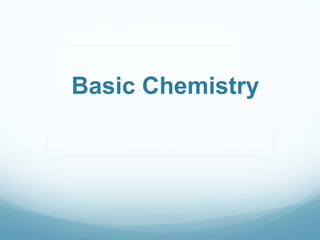Biochemistry--6.1 Basic Chemistry
•Télécharger en tant que PPT, PDF•
6 j'aime•1,972 vues
Atoms, Elements and Compounds
Signaler
Partager
Signaler
Partager

Recommandé
Recommandé
Contenu connexe
Tendances
Tendances (20)
Octet rule, lewis structure and formal charge (NOCB)

Octet rule, lewis structure and formal charge (NOCB)
Biology - Chp 2 - The Chemistry Of Life - PowerPoint

Biology - Chp 2 - The Chemistry Of Life - PowerPoint
Similaire à Biochemistry--6.1 Basic Chemistry
Similaire à Biochemistry--6.1 Basic Chemistry (20)
Plus de kathy_lambert
Plus de kathy_lambert (20)
6.4 organic compounds notes(teacher)for slideshare

6.4 organic compounds notes(teacher)for slideshare
Dernier
https://app.box.com/s/7hlvjxjalkrik7fb082xx3jk7xd7liz3TỔNG ÔN TẬP THI VÀO LỚP 10 MÔN TIẾNG ANH NĂM HỌC 2023 - 2024 CÓ ĐÁP ÁN (NGỮ Â...

TỔNG ÔN TẬP THI VÀO LỚP 10 MÔN TIẾNG ANH NĂM HỌC 2023 - 2024 CÓ ĐÁP ÁN (NGỮ Â...Nguyen Thanh Tu Collection
https://app.box.com/s/x7vf0j7xaxl2hlczxm3ny497y4yto33i80 ĐỀ THI THỬ TUYỂN SINH TIẾNG ANH VÀO 10 SỞ GD – ĐT THÀNH PHỐ HỒ CHÍ MINH NĂ...

80 ĐỀ THI THỬ TUYỂN SINH TIẾNG ANH VÀO 10 SỞ GD – ĐT THÀNH PHỐ HỒ CHÍ MINH NĂ...Nguyen Thanh Tu Collection
Dernier (20)
Micro-Scholarship, What it is, How can it help me.pdf

Micro-Scholarship, What it is, How can it help me.pdf
TỔNG ÔN TẬP THI VÀO LỚP 10 MÔN TIẾNG ANH NĂM HỌC 2023 - 2024 CÓ ĐÁP ÁN (NGỮ Â...

TỔNG ÔN TẬP THI VÀO LỚP 10 MÔN TIẾNG ANH NĂM HỌC 2023 - 2024 CÓ ĐÁP ÁN (NGỮ Â...
80 ĐỀ THI THỬ TUYỂN SINH TIẾNG ANH VÀO 10 SỞ GD – ĐT THÀNH PHỐ HỒ CHÍ MINH NĂ...

80 ĐỀ THI THỬ TUYỂN SINH TIẾNG ANH VÀO 10 SỞ GD – ĐT THÀNH PHỐ HỒ CHÍ MINH NĂ...
Jual Obat Aborsi Hongkong ( Asli No.1 ) 085657271886 Obat Penggugur Kandungan...

Jual Obat Aborsi Hongkong ( Asli No.1 ) 085657271886 Obat Penggugur Kandungan...
UGC NET Paper 1 Mathematical Reasoning & Aptitude.pdf

UGC NET Paper 1 Mathematical Reasoning & Aptitude.pdf
Unit 3 Emotional Intelligence and Spiritual Intelligence.pdf

Unit 3 Emotional Intelligence and Spiritual Intelligence.pdf
Kodo Millet PPT made by Ghanshyam bairwa college of Agriculture kumher bhara...

Kodo Millet PPT made by Ghanshyam bairwa college of Agriculture kumher bhara...
Salient Features of India constitution especially power and functions

Salient Features of India constitution especially power and functions
NO1 Top Black Magic Specialist In Lahore Black magic In Pakistan Kala Ilam Ex...

NO1 Top Black Magic Specialist In Lahore Black magic In Pakistan Kala Ilam Ex...
General Principles of Intellectual Property: Concepts of Intellectual Proper...

General Principles of Intellectual Property: Concepts of Intellectual Proper...
Biochemistry--6.1 Basic Chemistry
- 2. Why do we study chemistry in biology class? Because everything is made of different kinds of elements
- 3. What is Matter Made of? Answer; Atoms Atoms are composed of; a. Nucleus • Center of the atom • Contains protons (positive) & neutrons (neutral) b. Electron cloud • Surrounding the nucleus • Contains electrons (negative)
- 5. Atom
- 6. Elements An element is a pure substance that cannot be broken down into other substances by physical or chemical means. Made of only one type of atom
- 7. F.Y.I. 92 naturally occurring elements 26 found in living things Only 6 elements make up nearly the entire weight of an organism! 20 trace elements occur in your bodies.
- 8. Big “6” (Actually Big “4”) What happens when you mess up driving? People “HONC” at you! - Hydrogen (H) 10% of an animal’s weight - Oxygen (O) 63% of an animal’s weight - Nitrogen (N) 4% of an animal’s weight (Makes up genes and proteins) - Carbon (C ) 19% of an animal’s weight
- 9. The Big 6
- 11. Bonding forms Compounds 1. Elements can combine to form more complex substances. 2. Compounds are formed when two or more substances combine in a chemical bond. 3. There are two main types of bonds: o Ionic bonds o Covalent bonds 1. All bonds involve the atom’s electrons (particularly the outermost, valence, electrons)
- 12. 5. Why do elements want to bond together? Atoms want to have full energy levels, this makes them stable. Energy Levels are where the electrons are found- each level can hold a specific number of electrons Ex. 1st level = 2 electrons 2nd level = 8 electrons
- 13. Atoms become more stable by losing electrons or attracting electrons from other atoms - this results in a chemical bond.
- 14. Covalent Bonding Chemical bond formed when electrons are shared. Hint: Covalent = Cooperate Example: The oxygen atoms below are sharing their valence electrons in order to have a complete outer shell of electrons.
- 15. Ionic Bonding Created when atoms give up (donate) or obtain (accept) electrons to empty or fill the outer energy level. The atom that loses the electron(s) becomes positive The atom that gains the electron(s) becomes negative. Atoms that have a positive or negative charge are called Ions
- 16. Example of an Ionic Bond
- 17. Time for Questions! 1. What are the four main elements that make up living things? 2. When is an atom considered chemically stable? 3. What are the two main types of bonds that atoms form? 4. What is the main difference between the two types of bonds you listed above?